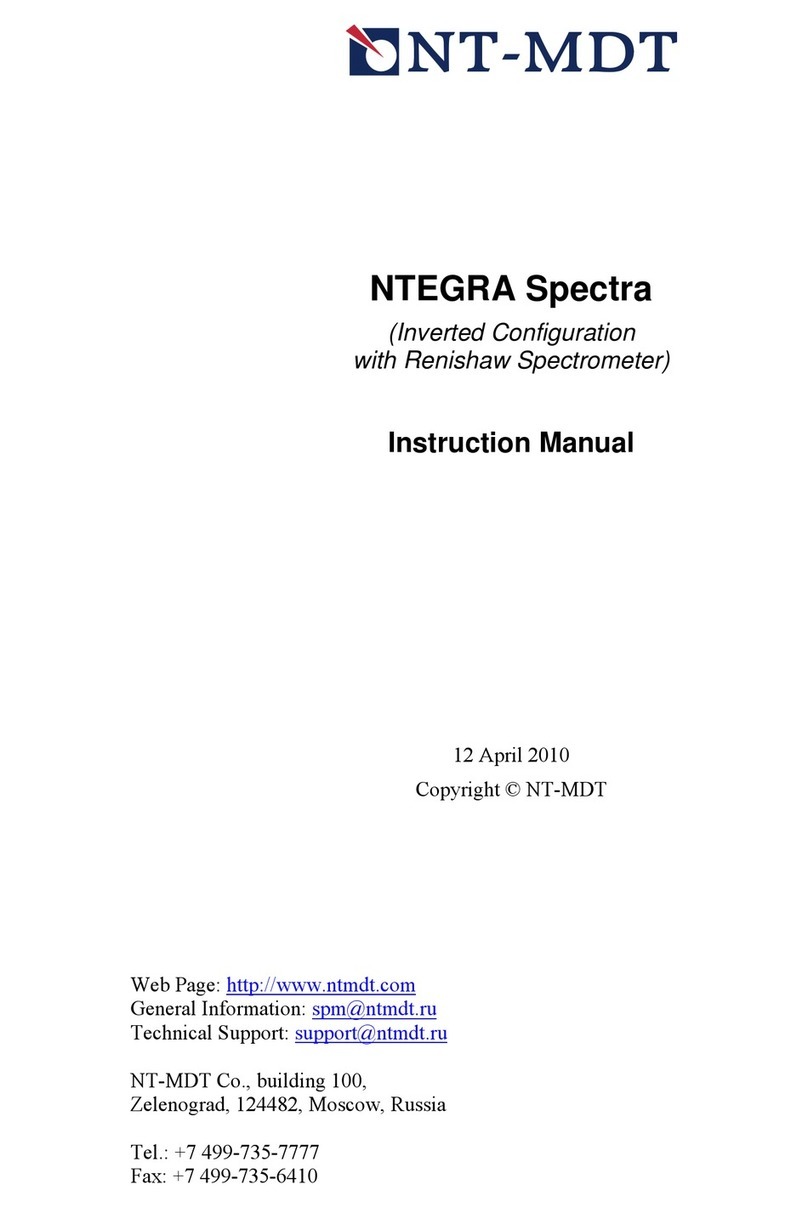
NTEGRA Solaris Probe NanoLaboratory
4
NTEGRA Solaris Probe NanoLaboratory
Table of Contents
1. BASIC INFORMATION ......................................................................................................................... 5
1.1. PURPOSE OF THE NTEGRA SOLARIS................................................................................................ 5
1.2. DESCRIPTION OF MAIN COMPONENTS .............................................................................................. 6
1.2.1. Inverted Optical Microscope Olympus IX71......................................................................... 7
1.2.2. NTEGRA Base Unit............................................................................................................... 8
1.2.3. XY Scanning Exchangeable Mount ....................................................................................... 9
1.2.4. SNOM Measuring Head...................................................................................................... 11
1.2.5. Optical Fiber Probe ............................................................................................................ 13
1.2.6. Laser Module ...................................................................................................................... 14
1.2.7. Photomultiplier Modules..................................................................................................... 15
1.2.8. SPM Controller ................................................................................................................... 17
1.2.9. Vibration Isolation Table .................................................................................................... 17
1.2.10. Optical Viewing System.................................................................................................. 18
1.3. THEORY OF OPERATION OF NTEGRA SOLARIS.............................................................................. 18
1.4. SAFETY MEASURES ........................................................................................................................ 23
1.5. OPERATING CONDITIONS ................................................................................................................ 25
1.6. STORAGE AND TRANSPORT INSTRUCTIONS ..................................................................................... 27
2. FIRST TIME INSTALLATION ........................................................................................................... 28
2.1. ASSEMBLY OF MAIN MODULES ...................................................................................................... 28
2.2. INSTALLATION OF INTERCONNECTIONS BETWEEN PARTS OF THE INSTRUMENT .............................. 32
3. PREPARATION OF THE NTEGRA SOLARIS PNL FOR OPERATION ..................................... 33
3.1. MAIN STEPS OF PREPARATION FOR OPERATION ............................................................................. 33
3.2. CABLE CONNECTIONS..................................................................................................................... 33
3.3. INSTALLATION OF THE PROBE INTO THE MEASURING HEAD ........................................................... 36
3.4. ASSEMBLY OF THE LASER MODULE................................................................................................ 39
3.5. PREPARATION AND INSTALLATION OF THE OPTICAL FIBER IN THE LASER MODULE ....................... 42
3.6. LOADING THE SAMPLE.................................................................................................................... 44
3.7. INSTALLATION OF THE MEASURING HEAD ON THE SCANNING MOUNT .......................................... 44
3.8. ASSEMBLY OF OPTICAL SCHEME FOR TRANSMISSION MODE.......................................................... 46
3.9. ASSEMBLY OF OPTICAL SCHEME FOR REFLECTION MODE.............................................................. 49
4. MEASUREMENT PROCEDURE ........................................................................................................ 54
4.1. SETTING OF THE INSTRUMENT CONFIGURATION ............................................................................. 54
4.2. LOADING SCANNER CALIBRATION PARAMETERS ........................................................................... 55
4.3. SETTING OF THE PHOTOMULTIPLIER MODULE PARAMETERS .......................................................... 57
4.4. SEARCH FOR RESONANCE FREQUENCY........................................................................................... 59
4.5. PROBE LANDING ............................................................................................................................. 62
4.6. SCANNING....................................................................................................................................... 64
4.6.1. Setting of Scanning Parameters .......................................................................................... 64
4.6.2. Triggering of Scanning ....................................................................................................... 66
4.6.3. Methods of Improving Image Quality ................................................................................. 67
4.7. SAVING OF MEASUREMENT RESULTS ............................................................................................. 68
4.8. TERMINATION OF MEASUREMENTS................................................................................................. 68
5. MAINTENANCE.................................................................................................................................... 70
5.1. ADJUSTING THE DISPLACEMENT SENSORS...................................................................................... 70
5.2. SCANNER CALIBRATION.................................................................................................................. 73





























